What is a VHF/UHF Repeater in Amateur Radio?
What is a VHF/UHF Repeater in Amateur Radio?
Unlike High Frequency (HF) signals, VHF/UHF (Very High Frequency/Ultra High Frequency) signals travel in ‘line of sight’ or rather a take a straight line path. In case of HF there is a ground wave which covers locally and a sky wave which bounces off the ionosphere, giving them a large range globally. But the range VHF/UHF transceivers are limited on simplex operation. To enhance the range we need repeaters which are transceivers which receive the signal and retransmit on a different frequency.

In case of VHF in my locality, the usual shift is -600 KHz, that is the difference between the two frequencies. The repeater also amplifies the received signal before retransmitting. Higher shifts are used in UHF and microwave bands, which I have not operated on! So while working through repeater, the transceiver has to be on duplex mode with a difference between the transmitted and received frequencies as set by the repeater. The shift is required to prevent the repeater’s receiver being drowned by its own transmitted signal as both operate continuously.